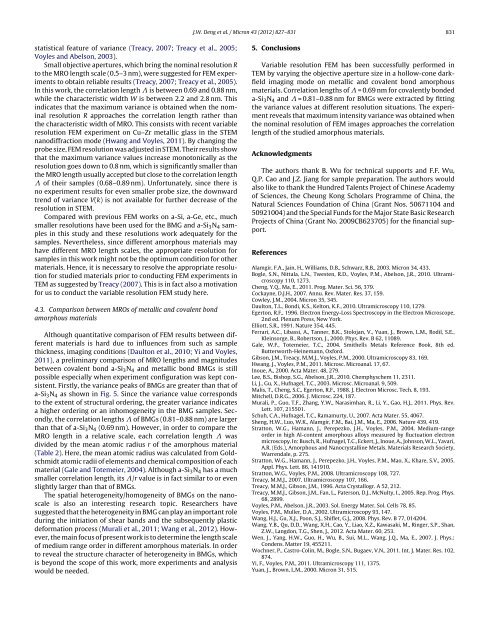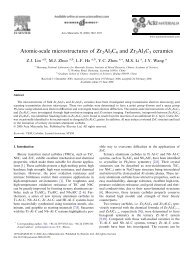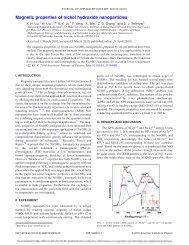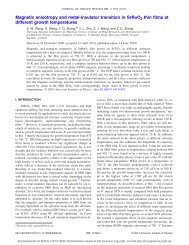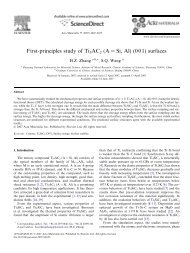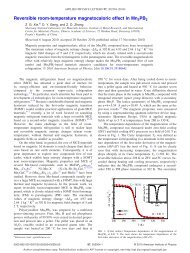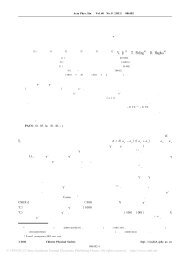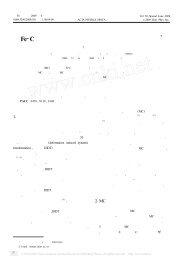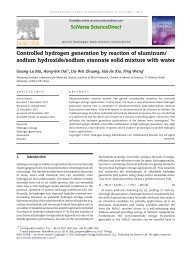Medium range order of bulk metallic glasses determined by variable ...
Medium range order of bulk metallic glasses determined by variable ...
Medium range order of bulk metallic glasses determined by variable ...
You also want an ePaper? Increase the reach of your titles
YUMPU automatically turns print PDFs into web optimized ePapers that Google loves.
J.W. Deng et al. / Micron 43 (2012) 827–831 831<br />
statistical feature <strong>of</strong> variance (Treacy, 2007; Treacy et al., 2005;<br />
Voyles and Abelson, 2003).<br />
Small objective apertures, which bring the nominal resolution R<br />
to the MRO length scale (0.5–3 nm), were suggested for FEM experiments<br />
to obtain reliable results (Treacy, 2007; Treacy et al., 2005).<br />
In this work, the correlation length is between 0.69 and 0.88 nm,<br />
while the characteristic width W is between 2.2 and 2.8 nm. This<br />
indicates that the maximum variance is obtained when the nominal<br />
resolution R approaches the correlation length rather than<br />
the characteristic width <strong>of</strong> MRO. This consists with recent <strong>variable</strong><br />
resolution FEM experiment on Cu–Zr <strong>metallic</strong> glass in the STEM<br />
nanodiffraction mode (Hwang and Voyles, 2011). By changing the<br />
probe size, FEM resolution was adjusted in STEM. Their results show<br />
that the maximum variance values increase monotonically as the<br />
resolution goes down to 0.8 nm, which is significantly smaller than<br />
the MRO length usually accepted but close to the correlation length<br />
<strong>of</strong> their samples (0.68–0.89 nm). Unfortunately, since there is<br />
no experiment results for even smaller probe size, the downward<br />
trend <strong>of</strong> variance V(k) is not available for further decrease <strong>of</strong> the<br />
resolution in STEM.<br />
Compared with previous FEM works on a-Si, a-Ge, etc., much<br />
smaller resolutions have been used for the BMG and a-Si 3 N 4 samples<br />
in this study and these resolutions work adequately for the<br />
samples. Nevertheless, since different amorphous materials may<br />
have different MRO length scales, the appropriate resolution for<br />
samples in this work might not be the optimum condition for other<br />
materials. Hence, it is necessary to resolve the appropriate resolution<br />
for studied materials prior to conducting FEM experiments in<br />
TEM as suggested <strong>by</strong> Treacy (2007). This is in fact also a motivation<br />
for us to conduct the <strong>variable</strong> resolution FEM study here.<br />
4.3. Comparison between MROs <strong>of</strong> <strong>metallic</strong> and covalent bond<br />
amorphous materials<br />
Although quantitative comparison <strong>of</strong> FEM results between different<br />
materials is hard due to influences from such as sample<br />
thickness, imaging conditions (Daulton et al., 2010; Yi and Voyles,<br />
2011), a preliminary comparison <strong>of</strong> MRO lengths and magnitudes<br />
between covalent bond a-Si 3 N 4 and <strong>metallic</strong> bond BMGs is still<br />
possible especially when experiment configuration was kept consistent.<br />
Firstly, the variance peaks <strong>of</strong> BMGs are greater than that <strong>of</strong><br />
a-Si 3 N 4 as shown in Fig. 5. Since the variance value corresponds<br />
to the extent <strong>of</strong> structural <strong>order</strong>ing, the greater variance indicates<br />
a higher <strong>order</strong>ing or an inhomogeneity in the BMG samples. Secondly,<br />
the correlation lengths <strong>of</strong> BMGs (0.81–0.88 nm) are larger<br />
than that <strong>of</strong> a-Si 3 N 4 (0.69 nm). However, in <strong>order</strong> to compare the<br />
MRO length in a relative scale, each correlation length was<br />
divided <strong>by</strong> the mean atomic radius r <strong>of</strong> the amorphous material<br />
(Table 2). Here, the mean atomic radius was calculated from Goldschmidt<br />
atomic radii <strong>of</strong> elements and chemical composition <strong>of</strong> each<br />
material (Gale and Totemeier, 2004). Although a-Si 3 N 4 has a much<br />
smaller correlation length, its /r value is in fact similar to or even<br />
slightly larger than that <strong>of</strong> BMGs.<br />
The spatial heterogeneity/homogeneity <strong>of</strong> BMGs on the nanoscale<br />
is also an interesting research topic. Researchers have<br />
suggested that the heterogeneity in BMG can play an important role<br />
during the initiation <strong>of</strong> shear bands and the subsequently plastic<br />
deformation process (Murali et al., 2011; Wang et al., 2012). However,<br />
the main focus <strong>of</strong> present work is to determine the length scale<br />
<strong>of</strong> medium <strong>range</strong> <strong>order</strong> in different amorphous materials. In <strong>order</strong><br />
to reveal the structure character <strong>of</strong> heterogeneity in BMGs, which<br />
is beyond the scope <strong>of</strong> this work, more experiments and analysis<br />
would be needed.<br />
5. Conclusions<br />
Variable resolution FEM has been successfully performed in<br />
TEM <strong>by</strong> varying the objective aperture size in a hollow-cone darkfield<br />
imaging mode on <strong>metallic</strong> and covalent bond amorphous<br />
materials. Correlation lengths <strong>of</strong> = 0.69 nm for covalently bonded<br />
a-Si 3 N 4 and = 0.81–0.88 nm for BMGs were extracted <strong>by</strong> fitting<br />
the variance values at different resolution situations. The experiment<br />
reveals that maximum intensity variance was obtained when<br />
the nominal resolution <strong>of</strong> FEM images approaches the correlation<br />
length <strong>of</strong> the studied amorphous materials.<br />
Acknowledgments<br />
The authors thank B. Wu for technical supports and F.F. Wu,<br />
Q.P. Cao and J.Z. Jiang for sample preparation. The authors would<br />
also like to thank the Hundred Talents Project <strong>of</strong> Chinese Academy<br />
<strong>of</strong> Sciences, the Cheung Kong Scholars Programme <strong>of</strong> China, the<br />
Natural Sciences Foundation <strong>of</strong> China (Grant Nos. 50671104 and<br />
50921004) and the Special Funds for the Major State Basic Research<br />
Projects <strong>of</strong> China (Grant No. 2009CB623705) for the financial support.<br />
References<br />
Alamgir, F.A., Jain, H., Williams, D.B., Schwarz, R.B., 2003. Micron 34, 433.<br />
Bogle, S.N., Nittala, L.N., Twesten, R.D., Voyles, P.M., Abelson, J.R., 2010. Ultramicroscopy<br />
110, 1273.<br />
Cheng, Y.Q., Ma, E., 2011. Prog. Mater. Sci. 56, 379.<br />
Cockayne, D.J.H., 2007. Annu. Rev. Mater. Res. 37, 159.<br />
Cowley, J.M., 2004. Micron 35, 345.<br />
Daulton, T.L., Bondi, K.S., Kelton, K.F., 2010. Ultramicroscopy 110, 1279.<br />
Egerton, R.F., 1996. Electron Energy-Loss Spectroscopy in the Electron Microscope,<br />
2nd ed. Plenum Press, New York.<br />
Elliott, S.R., 1991. Nature 354, 445.<br />
Ferrari, A.C., Libassi, A., Tanner, B.K., Stolojan, V., Yuan, J., Brown, L.M., Rodil, S.E.,<br />
Kleinsorge, B., Robertson, J., 2000. Phys. Rev. B 62, 11089.<br />
Gale, W.F., Totemeier, T.C., 2004. Smithells Metals Reference Book, 8th ed.<br />
Butterworth-Heinemann, Oxford.<br />
Gibson, J.M., Treacy, M.M.J., Voyles, P.M., 2000. Ultramicroscopy 83, 169.<br />
Hwang, J., Voyles, P.M., 2011. Microsc. Microanal. 17, 67.<br />
Inoue, A., 2000. Acta Mater. 48, 279.<br />
Lee, B.S., Bishop, S.G., Abelson, J.R., 2010. Chemphyschem 11, 2311.<br />
Li, J., Gu, X., Hufnagel, T.C., 2003. Microsc. Microanal. 9, 509.<br />
Malis, T., Cheng, S.C., Egerton, R.F., 1988. J. Electron Microsc. Tech. 8, 193.<br />
Mitchell, D.R.G., 2006. J. Microsc. 224, 187.<br />
Murali, P., Guo, T.F., Zhang, Y.W., Narasimhan, R., Li, Y., Gao, H.J., 2011. Phys. Rev.<br />
Lett. 107, 215501.<br />
Schuh, C.A., Hufnagel, T.C., Ramamurty, U., 2007. Acta Mater. 55, 4067.<br />
Sheng, H.W., Luo, W.K., Alamgir, F.M., Bai, J.M., Ma, E., 2006. Nature 439, 419.<br />
Stratton, W.G., Hamann, J., Perepezko, J.H., Voyles, P.M., 2004. <strong>Medium</strong>-<strong>range</strong><br />
<strong>order</strong> in high Al-content amorphous alloys measured <strong>by</strong> fluctuation electron<br />
microscopy. In: Busch, R., Hufnagel, T.C., Eckert, J., Inoue, A., Johnson, W.L., Yavari,<br />
A.R. (Eds.), Amorphous and Nanocrystalline Metals. Materials Research Society,<br />
Warrendale, p. 275.<br />
Stratton, W.G., Hamann, J., Perepezko, J.H., Voyles, P.M., Mao, X., Khare, S.V., 2005.<br />
Appl. Phys. Lett. 86, 141910.<br />
Stratton, W.G., Voyles, P.M., 2008. Ultramicroscopy 108, 727.<br />
Treacy, M.M.J., 2007. Ultramicroscopy 107, 166.<br />
Treacy, M.M.J., Gibson, J.M., 1996. Acta Crystallogr. A 52, 212.<br />
Treacy, M.M.J., Gibson, J.M., Fan, L., Paterson, D.J., McNulty, I., 2005. Rep. Prog. Phys.<br />
68, 2899.<br />
Voyles, P.M., Abelson, J.R., 2003. Sol. Energy Mater. Sol. Cells 78, 85.<br />
Voyles, P.M., Muller, D.A., 2002. Ultramicroscopy 93, 147.<br />
Wang, H.J., Gu, X.J., Poon, S.J., Shiflet, G.J., 2008. Phys. Rev. B 77, 014204.<br />
Wang, Y.B., Qu, D.D., Wang, X.H., Cao, Y., Liao, X.Z., Kawasaki, M., Ringer, S.P., Shan,<br />
Z.W., Langdon, T.G., Shen, J., 2012. Acta Mater. 60, 253.<br />
Wen, J., Yang, H.W., Guo, H., Wu, B., Sui, M.L., Wang, J.Q., Ma, E., 2007. J. Phys.:<br />
Condens. Matter 19, 455211.<br />
Wochner, P., Castro-Colin, M., Bogle, S.N., Bugaev, V.N., 2011. Int. J. Mater. Res. 102,<br />
874.<br />
Yi, F., Voyles, P.M., 2011. Ultramicroscopy 111, 1375.<br />
Yuan, J., Brown, L.M., 2000. Micron 31, 515.


